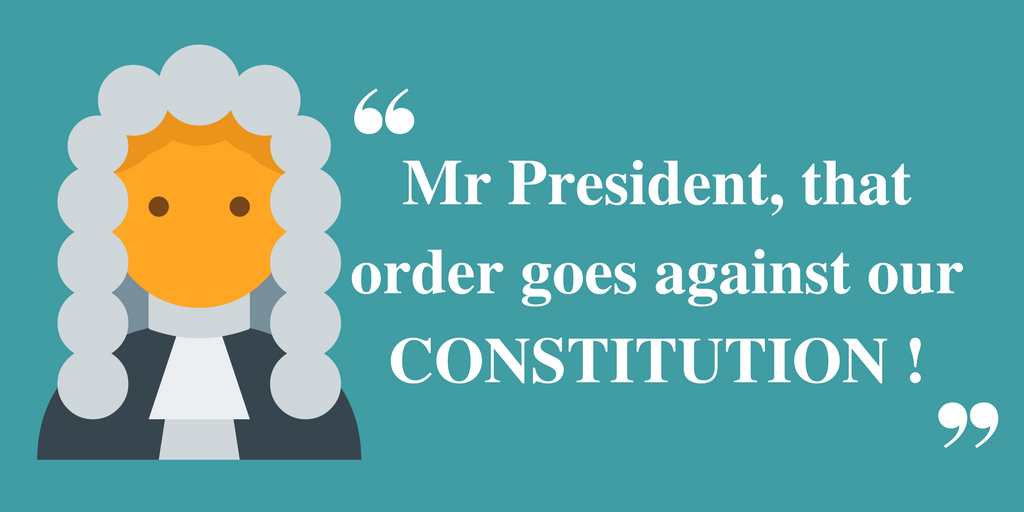
Have you ever heard this term and wondered what is the separation of powers exactly, and why is it so important? If so, then read on because we are going to explain it!

Brandon Mowinkel / Unsplash
Separation of powers isn’t a new idea – in fact, even the Ancient Greeks had a version of this political system, as did the Romans. There are variations in place across the world.
Each country has a slightly different setup, so we’ll use the United States to explain the concept.
What is the Separation of Powers?
The idea behind it is to have a system in place that prevents one person or group from having all the power over an entire country. If you think back to the days when countries were ruled by a king or queen, who made decisions that affected the lives of everyone who lived in their kingdom – sometimes that went well, but often it didn’t. Instead of one person having all the power, a democracy splits the power between different people or groups of people.
 When you think of the person who runs the country, you probably think of the President. The President represents the EXECUTIVE branch of the government.
When you think of the person who runs the country, you probably think of the President. The President represents the EXECUTIVE branch of the government.
In the USA, that means that the President executes the instructions of Congress, signs Executive Orders, selects judges to be approved by Congress, and is in charge of the armed forces (the navy, army and airforce).
By the way – don’t get confused by the word ‘execute’, which can mean ‘to put to death, to murder’ but can also mean ‘to carry out, to accomplish’. The President carries out the instructions from Congress, he doesn’t kill them all!
 What is Congress? Congress is the LEGISLATIVE and is made up of the House of Representatives and the Senate.
What is Congress? Congress is the LEGISLATIVE and is made up of the House of Representatives and the Senate.
Have a look here to find out more about Congress and how they are elected. Laws are introduced by members of Congress and presented to the President for his signature ![]() or veto
or veto ![]()
Congress is also in charge of the budget. This means that they dcide how to raise money for the country, via taxes, and what to spend it on. Not happy with the state of your school – write to your Congressperson!
Congress decides if the country goes to war, oversees and investigates the government, and can remove public officials from office if they do something that is against the law. This is called impeachment.

Finally, we come to the JUDICIAL. There is a clue in the name! It’s the judges, and specifically in the US, the Supreme Court.
They are responsible for ensuring that the laws passed by Congress, and the actions of the President are in accordance with the Constitution.
What is the Constitution?
The Constitution is a legal document which came into force in 1789 and lays out the basic legal framework of the United States of America. It has been amended 27 times since then, to reflect the changes in the country.
To show you how much the country changed – when the Constitution was written, it included this section, which deals with how the USA calculates the numbers of citizens living in every state in the country. This was important because the number of people living in each state determined how many Representatives were sent to Congress from each state.
Article I, Section. 2
Representatives and direct Taxes shall be apportioned among the several States which may be included within this Union, according to their respective Numbers, which shall be determined by adding to the whole Number of free Persons, including those bound to Service for a Term of Years, and excluding Indians not taxed, three fifths of all other Persons.
The ‘whole number of free persons‘ – each FREE person was counted, so anyone who wasn’t a slave. Remember when the Constitution was written, slavery still existed in the southern states. ‘Excluding Indians not taxed‘ – by this they mean they didn’t count Native Americans who were living on reservations. ‘3/5th of all other persons‘ – this refers to slaves, who weren’t counted as a whole person.
The 13th Amendment abolished slavery in 1865, and further Amendments, together with Civil Rights legislation made it illegal to discriminate against people because of their skin colour or heritage.
Why is the Separation of Powers Important to a Democracy
When you learn about the separation of powers, you’ll hear the phrase ‘Checks and Balances’ a lot. By this, we mean the processes that are in place to check the power of the President, Congress, and the Judges. Each of these three branches of government acts as a kind of emergency brake. Without this safeguard, there is a danger that a dictator could take over the country. A dictator is someone who rules the country with absolute power, often in a cruel or unusual way.
Dictators arrest people who disagreed with them, treat them badly and may even kill them. They don’t allow the press to speak freely about what is going on in the country, they shut newspapers down, stop TV stations broadcasting, block the internet to prevent citizens organising protests.
Let’s look at an example of a way in which checks and balances work. Say the President wrote an Executive Order –

Any adult who didn’t have an orange face had to go to jail and the kids weren’t allowed to go to school. The President sent the police around the cities and village to check everyone had orange faces.
Some brave children stand up and say ‘No! We want to go to school (although we wouldn’t mind being given less homework) and we don’t want orange faces. We think that this order from the President isn’t right, and is probably against the law. We are going to the courts, to ask the judges to decide if this order is legal!’

The judges are in agreement. The order is unconstitutional. Now obviously there is no line in the constitution that says ‘No President shall declare that all citizens of the United States shall have orange faces’. The original framers (writers) of the document knew that they couldn’t list every single potential law that might come up, and of course, since it was written so much has changed.
As we mentioned above, the Constitution paints broad strokes and deals with basics rights such as free speech, free press, the right of assembly (to demonstrate if you are unhappy with a decision made by politicians), the right to a fair trial, and of course the rights of equality under the law.
Over the years, court battles have been fought and Constitutional Law established. This means that the judges look back at what previous judges have determined and they can base their decisions on these precedents (examples of decisions). Or they can express a different opinion, as long as they present a legal argument that the other judges can follow. There are nine judges on the court and after the case has been presented to them, they vote. If enough of them vote that an Executive Order is unconstitutional, then the President has to change it or abandon it.
Another way for the President’s Orange Face Order to be overturned is by Congress.

Strictly speaking, it isn’t a block but Congress does have ways of preventing an Executive Order from being enforced. They can ask the Supreme Court to rule on the legal situation. They can introduce a law like the one described above, but this has to be presented to the President, and remember – he’s allowed to veto a bill (refuse to sign it). They can work with the President to introduce a law that both sides are happy to sign.
Separation of Powers ensures that each branch of government works independently, and they are not allowed to interfere in the decision making of the other branches, e.g. the President isn’t allowed to tell the judges what to do or override their decisions.
You can find out more about the US Congress, the President and the US Election here.
Over to one of the Founding Fathers – Alexander Hamilton – the musical of his life story is a huge hit around the world.
The UK has a parliamentary democracy and our Head of State is HR Queen Elizabeth. The British system is slightly different because the Head of State isn’t an elected President but they too have a way of limiting the power of each branch of government. You can find out more about the UK system here.

TEACHERS – Download this QR code to share this blog post with your students.



